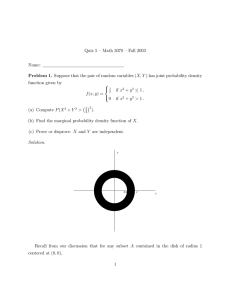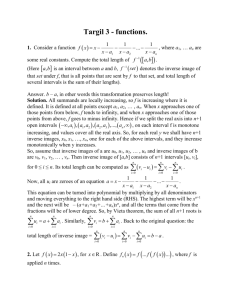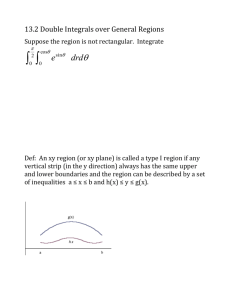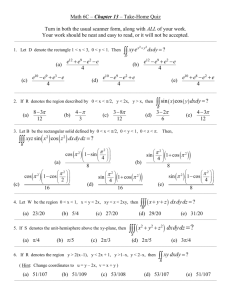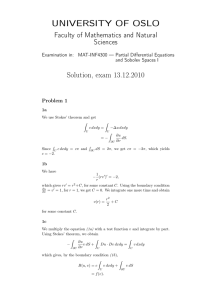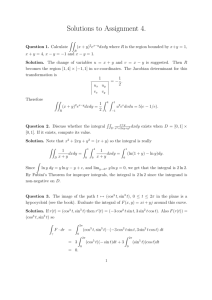Joint Distribution Functions: Probability Theory
advertisement
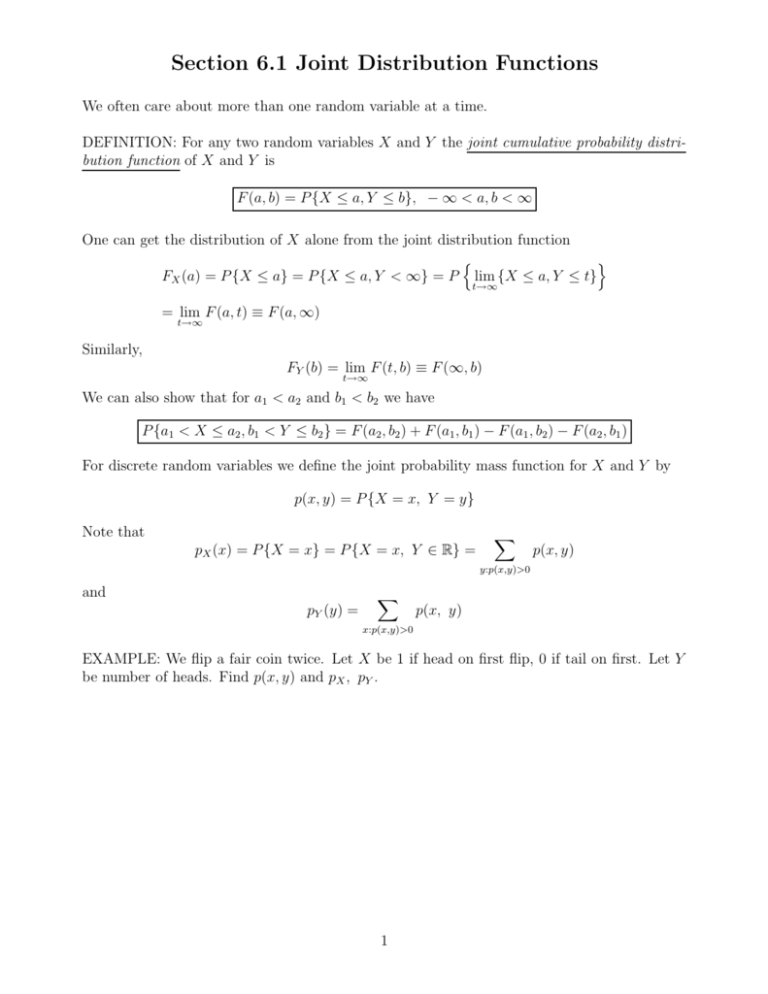
Section 6.1 Joint Distribution Functions
We often care about more than one random variable at a time.
DEFINITION: For any two random variables X and Y the joint cumulative probability distribution function of X and Y is
F (a, b) = P {X ≤ a, Y ≤ b}, − ∞ < a, b < ∞
One can get the distribution of X alone from the joint distribution function
n
o
FX (a) = P {X ≤ a} = P {X ≤ a, Y < ∞} = P lim {X ≤ a, Y ≤ t}
t→∞
= lim F (a, t) ≡ F (a, ∞)
t→∞
Similarly,
FY (b) = lim F (t, b) ≡ F (∞, b)
t→∞
We can also show that for a1 < a2 and b1 < b2 we have
P {a1 < X ≤ a2 , b1 < Y ≤ b2 } = F (a2 , b2 ) + F (a1 , b1 ) − F (a1 , b2 ) − F (a2 , b1 )
For discrete random variables we define the joint probability mass function for X and Y by
p(x, y) = P {X = x, Y = y}
Note that
pX (x) = P {X = x} = P {X = x, Y ∈ R} =
X
p(x, y)
y:p(x,y)>0
and
pY (y) =
X
p(x, y)
x:p(x,y)>0
EXAMPLE: We flip a fair coin twice. Let X be 1 if head on first flip, 0 if tail on first. Let Y
be number of heads. Find p(x, y) and pX , pY .
1
EXAMPLE: We flip a fair coin twice. Let X be 1 if head on first flip, 0 if tail on first. Let Y
be number of heads. Find p(x, y) and pX , pY .
Solution: The ranges for X and Y are {0, 1}, {0, 1, 2}, respectively. We have
p(0, 0) = P (X = 0, Y = 0) = P (X = 0)P (Y = 0 | X = 0) = (1/2)(1/2) = 1/4
p(0, 1) = P (X = 0, Y = 1) = P (X = 0)P (Y = 1 | X = 0) = (1/2)(1/2) = 1/4
p(0, 2) = P (X = 0, Y = 2) = 0
p(1, 0) = P (X = 1, Y = 0) = 0
p(1, 1) = P (X = 1, Y = 1) = P (X = 1)P (Y = 1 | X = 1) = (1/2)(1/2) = 1/4
p(1, 2) = P (X = 1, Y = 2) = P (X = 1)P (Y = 2 | X = 1) = (1/2)(1/2) = 1/4
.
x .. y
0
1
2 Row Sum = P {X = x}
0
1/4 1/4 0
1/2
1
0 1/4 1/4
1/2
Column Sum = P {Y = y} 1/4 1/2 1/4
Further,
pX (0) =
2
X
p(0, y) = p(0, 0) + p(0, 1) + p(0, 2) = 1/2
y=0
pX (1) =
2
X
p(1, y) = p(1, 0) + p(1, 1) + p(1, 2) = 1/2
y=0
pY (0) =
2
X
p(x, 0) = p(0, 0) + p(1, 0) = 1/4
x=0
pY (1) =
2
X
p(x, 1) = p(0, 1) + p(1, 1) = 1/2
x=0
pY (2) =
2
X
p(x, 2) = p(0, 2) + p(1, 2) = 1/4
x=0
DEFINITION: We say that X and Y are jointly continuous if there exists a function f (x, y)
defined for all x, y such that for any C ⊂ R2 we have
ZZ
P {(X, Y ) ∈ C} =
f (x, y)dxdy
(x,y)∈C
where f (x, y) is called the joint probability density function of X and Y .
Thus,
P {X ∈ A, Y ∈ B} =
Z Z
B A
2
f (x, y)dxdy
Also,
∂2
∂2
F (a, b) =
∂a∂b
∂a∂b
Zb Za
f (x, y)dxdy = f (a, b)
−∞ −∞
Similar to before, we view the joint density as a measure of the likelihood that the random
vector (X, Y ) will be in the vicinity of (a, b). As before,
P {a < X < a + da, b < Y < b + db} =
b+db
Z a+da
Z
f (x, y)dxdy ≈ f (a, b)dadb
b
a
where da and db should be thought of as very small.
We can find the marginal probability density functions as follows
P {X ∈ A} = P {X ∈ A, Y ∈ (−∞, ∞)} =
Z Z∞
A −∞
where
fX (x) =
Z∞
f (x, y)dydx =
Z
fX (x)dx
A
f (x, y)dy
−∞
is therefore the density function for X. Similarly,
fY (y) =
Z∞
f (x, y)dx
−∞
EXAMPLE: Suppose the joint density is
f (x, y) = 2e−x e−2y
if x, y > 0 and zero otherwise. Find the marginal of X, fX (x). Compute P {X > 1, Y < 1}
and P {X < Y }.
3
EXAMPLE: Suppose the joint density is
f (x, y) = 2e−x e−2y
if x, y > 0 and zero otherwise. Find the marginal of X, fX (x). Compute P {X > 1, Y < 1}
and P {X < Y }.
Solution: For x > 0 we have
fX (x) =
Z∞
f (x, y)dy =
Z∞
2e−x e−2y dy = e−x
0
−∞
Next,
P {X > 1, Y < 1} =
Z1 Z∞
0
−x −2y
2e e
dxdy =
1
Z1
2e−2y e−1 dy = e−1 (1 − e−2 )
0
Finally,
P {X < Y } =
ZZ
f (x, y)dxdy =
0
(x,y):x<y
=
Z∞
0
2e−2y dy −
Z∞
Z∞ Zy
2e−3y dy = 1 −
2e−x e−2y dxdy =
0
Z∞
2e−2y (1 − e−y )dy
0
2
1
=
3
3
0
Everything extends to more than two random variables in the obvious way. For example, for n
random variables we have
F (a1 , a2 , . . . , an ) = P {X1 ≤ a1 , X2 ≤ a2 , . . . , Xn ≤ an }
Also, joint probability mass functions and joint densities are defined in the obvious manner.
Section 6.2 Independent Random Variables
DEFINITION: Two random variables are said to be independent if for any two sets of real
numbers A and B we have
P {X ∈ A, X ∈ B} = P {X ∈ A}P {X ∈ B}
(1)
That is, the events EA = {X ∈ A} and FB = {Y ∈ B} are independent.
One can show that the above equation holds if and only if for all a and b we have
P {X ≤ a, Y ≤ b} = P {X ≤ a}P {Y ≤ b}
Therefore, two random variables X and Y are independent if and only if the joint distribution
function is the product of the marginal distribution functions:
F (a, b) = FX (a)FY (b)
4
It’s easy to see that for discrete random variables the condition (1) is satisfied if and only if
p(x, y) = pX (x)pY (y)
(2)
for all x, y where p(x, y) = P {X = x, Y = y} is the joint probability density function. This is
actually easy to show.
Proof: Note that (2) follows immediately from condition (1). However, for the other direction,
for any A and B we have
XX
XX
P {X ∈ A, Y ∈ B} =
p(x, y) =
pX (x)pY (y)
y∈B x∈A
=
X
y∈B
pY (y)
X
y∈B x∈A
pX (x) = P {Y ∈ B}P {X ∈ A} x∈A
Similarly, in the jointly continuous case independence is equivalent to
f (x, y) = fX (x)fY (y)
It should be clear that independence can be defined in the obvious manner for more than
two random variables. That is, X1 , X2 , . . . , Xn are independent if for all sets of real numbers
A1 , A2 , . . . , An we have
P {X1 ∈ A1 , X2 ∈ A2 , . . . , Xn ∈ An } =
n
Y
P {Xi ∈ Ai }
i=1
The obvious conditions for the joint probability mass functions (in the discrete case) and joint
densities (in the continuous case) hold. That is, in both cases independence is equivalent the
join probability mass function or density being equal to the respective product of the marginals.
EXAMPLES:
1. Let the joint density of X and Y be given by
f (x, y) = 6e−2x e−3y
for x, y > 0
and zero otherwise. Are these random variables independent?
5
1. Let the joint density of X and Y be given by
f (x, y) = 6e−2x e−3y
for x, y > 0
and zero otherwise. Are these random variables independent?
Solution: We compute the marginals. For x > 0 we have
fX (x) =
Z∞
6e−2x e−3y dy = 2e−2x
Z∞
6e−2x e−3y dx = 3e−3y
0
For Y we have
fY (y) =
0
Therefore, f (x, y) = fX (x)fY (y) for all x, y ∈ R (note that the relation also holds if one, or
both, of x and y are negative). Also, X is Exp(2), and Y is Exp(3).
2. Let the joint density of X and Y be given by
f (x, y) = 24xy
for 0 < x < 1, 0 < y < 1, 0 < x + y < 1
and zero otherwise. Are X and Y independent?
6
2. Let the joint density of X and Y be given by
f (x, y) = 24xy
for 0 < x < 1, 0 < y < 1, 0 < x + y < 1
and zero otherwise. Are X and Y independent?
Solution (see the book for another way to solve): Note that the domain in which f is nonzero depends upon an interplay between x and y. Therefore, you expect that these are not
independent. Let us compute the marginals. For x ∈ (0, 1) we have f (x, y) = 0 unless
0 < y < 1 − x. Therefore,
fX (x) =
Z∞
−∞
Z1−x
f (x, y)dy =
24xydy = 12x(1 − x)2
Z∞
Z1−y
24xydx = 12y(1 − y)2
f (x, y)dx =
0
Similarly,
fY (y) =
−∞
0
Therefore, we do not have f (x, y) = fX (x)fY (y) that for all x, y and hence X and Y are not
independent.
3. For i = 1, . . . , n, let Xi ∼ Exp(λi ) be independent exponential random variables with
parameters λi > 0. What is the distribution of the minimum of the Xi ?
Solution: Let Z = min{Xi }. Clearly, the range of Z is t > 0. Therefore
P {Z > t} = P {min{Xi } > t} = P {X1 > t, X2 > t, . . . , Xn > t}
= P {X1 > t}P {X2 > t} . . . P {Xn > t} (by independence)
(
n
X
= e−λ1 t e−λ2 t . . . e−λn t = exp −
i=1
λi
! )
t
It follows that for t ≥ 0 we have
(
FZ (t) = 1 − P {Z > t} = 1 − exp −
n
X
i=1
! )
λi t
therefore Z ∼ Exp(λ1 + . . . + λn ).
One natural way to interpret this result is the following: if n alarm clocks are set to go off after
an exponentially distributed amount of time (each with a potentially different rate λi ), then
the time that the first alarm rings is also exponentially distributed
with the parameter which
X
equals to the sum of the parameters of all the clocks, that is
λi .
i
7
